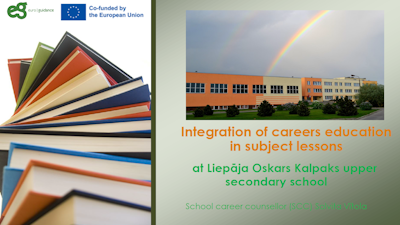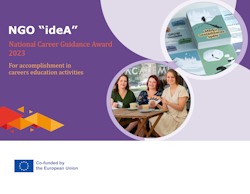Presentations of awarded practices in Latvia 2023
| Site: | Euroguidance Latvia Academy |
| Course: | KARJERAS BIBLIOTĒKA |
| Book: | Presentations of awarded practices in Latvia 2023 |
| Printed by: | Guest user |
| Date: | Wednesday, 24 December 2025, 7:59 PM |
Description
This section comprises presentations of awarded practices in Latvia. Translation of description of practices is provided by Euroguidance Latvia.
Co-funded by the European Union. Views and opinions expressed are however those of the author(s) only and do not necessarily reflect those of the European Union or EACEA. Neither the European Union nor the granting authority can be held responsible for them.
1. Digital portfolio for students
Author: Dina Brence
Career counsellor, Liepaja Raina Secondary School No 6
This good practice by Dina Brence has been awarded a National Career Guidance Award in 2023.
Translation of this presentation is provided by Euroguidance Latvia.
Description of the practice
Dina Brence has developed a method to facilitate development and assessment of digital career portfolios as a tool to help upper secondary school students relate their course work to various future careers. The compilation and presentation of student extra-curricular experiences also contributes to the development of their digital and self-presentation skills. The digital portfolio both aids future career decisions and is also useful during school for applying for scholarships, awards, summer jobs, internships, and crafting a first professional resume. The career counsellor plays a key role in building a student's portfolio by not only motivating a pupil to attend selected career-related events and document experiences but also advising how to reflect on and extract valuable insights from those experiences. This helps pupils connect their educational programs to their future career choices in a more informed way. Twice a year, the career counsellor assesses student portfolios, for which specific criteria have been developed. Advice and recommendations for improving the portfolio are given, and a conversation is held individually between the pupil and the career counsellor. Collaboration among fellow teachers is also instrumental in realizing the full potential of this method. Teachers actively contribute to students' digital skill development and overall growth by actively participating in portfolio-building activities.
Target group:
upper secondary school pupils
2. Integration of careers education into the curriculum
Author: Solvita Vītola
School career counsellor, Liepāja Oskars Kalpaks upper secondary School No 15 This good practice by Solvita Vītola has been awarded a National Career Guidance Award in 2023.
This good practice by Solvita Vītola has been awarded a National Career Guidance Award in 2023. Translation of this presentation is provided by Euroguidance Latvia.
Description of the practice
Career counsellor at Liepaja Secondary School No. 15, Solvita Vītola, underscores the importance of integrating careers education into the school curriculum. This bridges the gap between theoretical knowledge acquired in lessons and its real-world application. It concerns bringing pupils' knowledge, skills, and attitudes closer to practical life situations, thereby enhancing their motivation for further learning, and helping them make well-informed decisions about their future careers. Solvita's approach maximized the educational value of a field trip to a local Liepaja company for 8th grade pupils. This trip integrated topics in social studies such as "Production, Commercial Activity" and in geography, exploring the "Use of Natural Resources". During their visit, pupils gained insights into the company's utilization of resources, business operations, and the concept of a "patent" in a practical context. Additionally, pupils had the chance to observe representatives of various professions in action, helping them better understand potential career paths. Collaboration with subject teachers allowed for the development of integrated lessons, identifying career management skills within subject standards, curricula, and lesson topics. Solvita's efforts have fostered successful collaboration between the school, the local community, and the world of work.
Target group:
secondary school pupils3. The "Goal Setting Game"
Author: NGO "iDEA"
(Santa Leiboviča, Lauma Gulbe, Dace Vīpule-Kuļika)Description of the practice
The "Goal Setting Game" was designed to assist young people in clarifying their career aspirations, enabling them to set more concrete goals and devise strategies for achieving them. Through a series of guided open-ended questions, players engage in a dialogue that leads them to develop a well-defined action plan for reaching their objectives.
This game can be played individually or in collaboration with a career counsellor, teacher, parents, or a trusted mentor. For young individuals, it fosters a sense of personal responsibility, self-belief, the ability to surmount challenges, and a offers a wellspring of motivation for new accomplishments. It aids in organizing thoughts, identifying available resources, and outlining specific steps toward goal attainment. Simultaneously, for educators and parents, the game serves as a valuable tool for initiating meaningful conversations with young individuals about their aspirations, fostering purposeful dialogue. The game comprises 56 cards featuring precise questions that guide the thought structuring process and assist in formulating clear answers.
 Additionally, accompanying worksheets have been developed to facilitate recording responses and visualizing the goal-setting journey.
Additionally, accompanying worksheets have been developed to facilitate recording responses and visualizing the goal-setting journey.
Card sets are available in both Latvian and English, and this tool has garnered acclaim from career guidance users not only in Latvia but also internationally.

